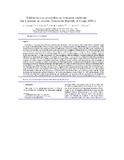| dc.description.abstract | Luiswishi is a Congo-type Neoproterozoic sediment-hosted stratiform Cu–Co ore deposit of the Central Africa Copperbelt, located
northwest of Lubumbashi (DRC). The ores form two main Cu–Co orebodies hosted by the Mines Subgroup, one in the lower part of the
Kamoto Formation and the other at the base of the Dolomitic Shales Formation. Sulphides occur essentially as early parallel layers of
chalcopyrite and carrolite, and secondarily as late stockwork sulphides cross-cutting the bedding and the early sulphide generation. Both
types of stratiform and stockwork chalcopyrite and carrolite were systematically analyzed for sulphur isotopes, along the lithostratigraphic
succession of the Mine Series. The quite similar d34S values of stratiform sulphides and late stockwork sulphides suggest an
in situ recrystallization or a slight remobilization of stockwork sulphides without attainment of isotopic equilibrium between different
sulphide phases (chalcopyrite and carrolite). The distribution of d34S values ( 14.4& to +17.5&) combined with the lithology indicates
a strong stratigraphic control of the sulphur isotope signature, supporting bacterial sulphate reduction during early diagenesis of the host
sediments, in a shallow marine to lacustrine environment. Petrological features combined with sulphur isotopic data of sulphides at
Luiswishi and previous results on nodules of anhydrite in the Mine Series indicate a dominant seawater/lacustrine origin for sulphates,
precluding a possible hydrothermal participation. The high positive d34S values of sulphides in the lower orebody at Luiswishi, hosted in
massive chloritic–dolomitic siltite (known as Grey R.A.T.), fine-grained stratified dolostone (D.Strat.) and silicified-stromatolitic dolomites
alternating with chloritic–dolomitic silty beds (R.S.F.), suggest that they were probably deposited during a period of regression in a
basin cut off from seawater. The variations of d34S values (i.e. the decrease of d34S values from the Kamoto Formation to the overlying
Dolomitic Shales and then the slight increase from S.D.2d to S.D.3a and S.D.3b members) are in perfect agreement with the inferred
lithological and transgressive–regressive evolution of the ore-hosting sedimentary rocks [Cailteux, J., 1994. Lithostratigraphy of the
Neoproterozoic Shaba-type (Zaire) Roan Supergroup and metallogenesis of associated stratiform mineralization. In: Kampunzu
A.B., Lubala, R.T. (Eds.), Neoproterozoic Belts of Zambia, Zaire and Namibia. Journal of African Earth Sciences 19, 279–301]. | en_US |

